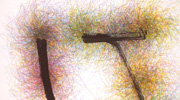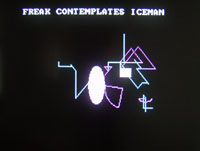|
DIE ALGORITHMISCHE REVOLUTION
ZKM:
Zentrum für Kunst und Karlsruhe, Germany |
THE ALGORITHMIC
REVOLUTION
Center for Art and Karlsruhe, Germany October 31 2004 |
||
| Introduction: Deutch | Introduction: English| | ||
| Work by Roman Verostko in this exhibition: | |||
| Struggle
Series #13 Algorithmic brush and pen drawing. Executed on Stonehenge paper in 1994. 42" by 40" The brush stroke procedure in this work dates from 1987. The artist built interactive code whereby the machine asks for a paint brush. The artist places the ink brush into the machine's drawing arm and the machine executes the brush stroke. For all the brush strokes shown here the same procedure was used. Each unique brush stroke has a self similar relationship to its accompanying pen strokes. Each work has a unique set of "control point" relationships. These were used to control the brush stroke and every pen stroke in each given work. |
|||
|
Detail:
Detail
shows, in this work, that the distribution of pen strokes are coded to
cluster close to the control points that were used to generate the path
for the brush stroke.
These procedures are deeply related to practices the artist used as a painter before he developed his coded procedures. |
|||
|
Front & End
Pieces
|
DERIVATION OF THE LAWS, Chapter III, Investigation of the laws of thought. . .by George Boole (1847), illustrated by Roman Verostko. Saint Sebastian Press, Minneapolis, 1990. ISBN: 1-879508-08-7
The book: This illustrated
limited edition of George Boole's 1847 classic on the laws of thought
was completed in 1990 to honor the origins of “Boolean logic”
that is central to computing technologies. This edition
exemplifies a radical new procedure whereby the same "parent"
code, created by the artist, generates a series of original drawings.
Each drawing, in this family of forms, bears a familial resemblance to
the others. This edition (1990) may be the first instance where an
algorithmic improvisational series of original drawings was created for
a bound limited edition. Text. The text is Chapter III from Boole's Classic work, An Investigation of the Laws of Thought... (Macmillan, London, 1859). This edition includes a Preface by Roger Malina, a statement by Roman and a Postscript.
Rationale. This
edition was created as a tribute to the 19th Century
mathematician George Boole (1815-1864). Boole’s treatise on the Laws
demonstrates the direct link between Aristotle’s principle of
contradiction and the symbolic logic known today as Boolean Algebra.
Boolean logic, a symbolic language seminal to the development of
modern circuit boards, is fundamental to programming languages. The
illustrations for this edition, generated with principles outlined
in Boole’s Laws, exemplify the profound kinship emerging today between
art and coded procedure. Edition. The limited edition of 125 copies, bound in leather, was pulled by hand at the St. Sebastian Press in Minneapolis in 1990. The type, Gill Sans, cast by M&H Type of San Francisco, is printed on Frankfurt text, with Kohl & Madden inks. The work was also issued in a reproduction paperback version based on the original type setting and plotter drawings (February 1991, ISBN 1-879508-07-9). The press is no longer active. The artist retains a limited number of copies of each edition.
Limited Edition Credits: |
||

|
The Magic Hand of Chance
(1982-1984). The ZKM holds a copy of the source code. The
Magic Hand display was added for the extended display of Algorithmic
Revolution. Software. The Magic Hand of Chance generates non-repeating text & graphics. Each sequence operates randomly within a set of coded instructions. The color monitor displays a graphic analogue of the computer working out the sequence as it follows the algorithm’s step-by-step instructions. For each move the artist’s instruction determines the range of syntactically acceptable random options. These might include which angle to turn and what color to assume for a graphic sequence or what word to choose in composing a title. Viewing format: The Magic Hand of Chance presents four IMPROVISATIONS and several PATHWAY sequences. Each new sequence receives a unique title followed by a graphic sequence. The improvisations are interspersed with "The Sayings of Omphalos", brief evocative phrases with a date and time stamp. One full viewing sequence requires about 10 minutes viewing time. Left: Sample of screens captured from animated sequences. Titles and graphic sequences are always original without any repetitions. |
||






